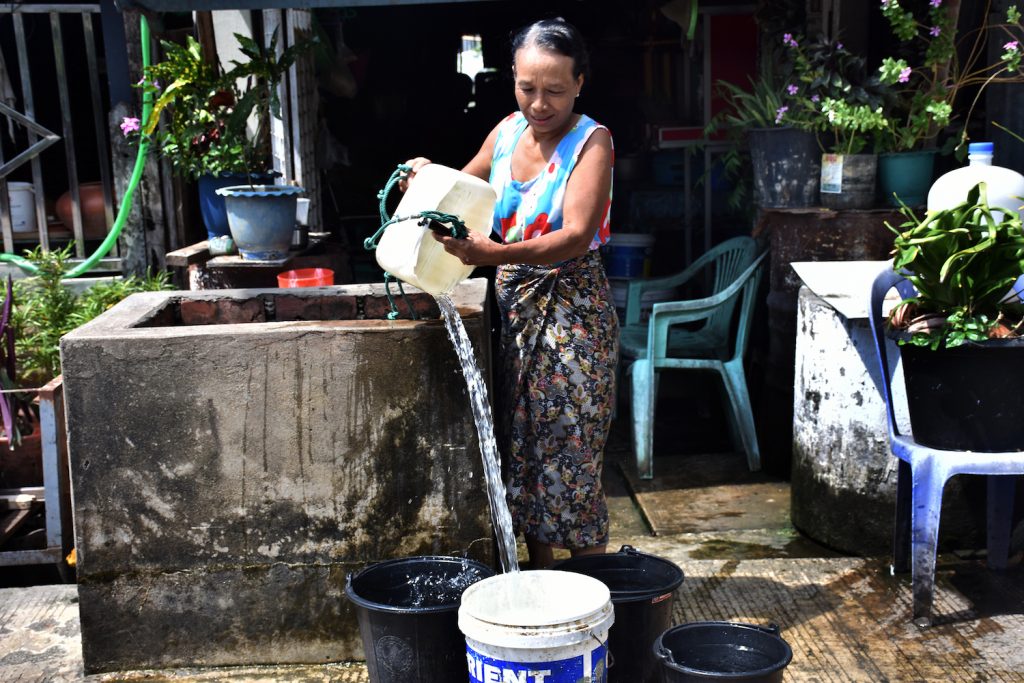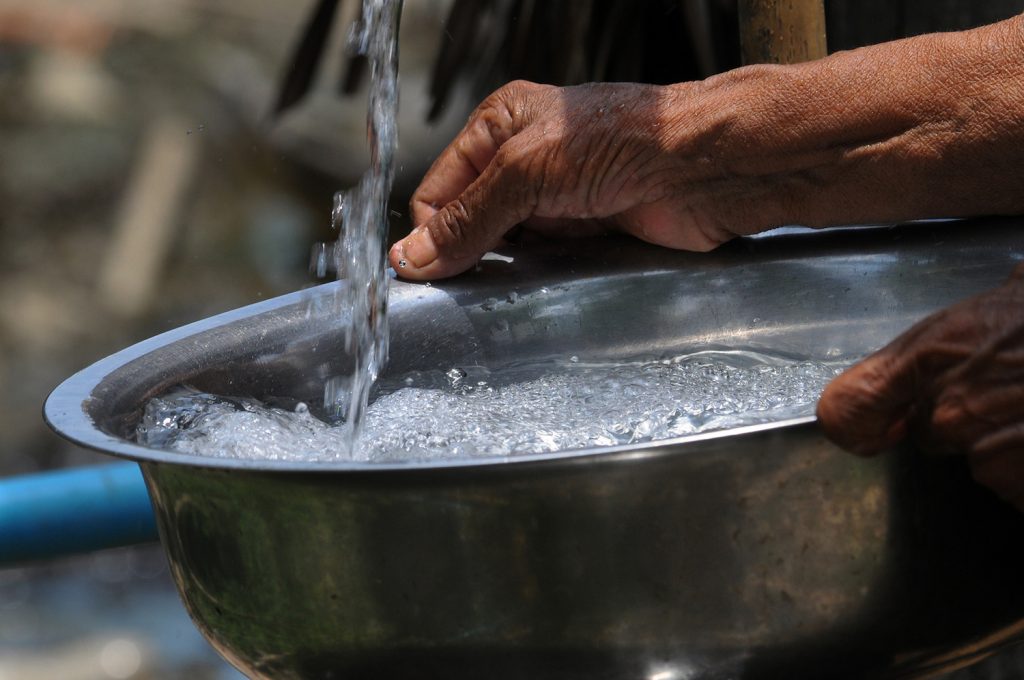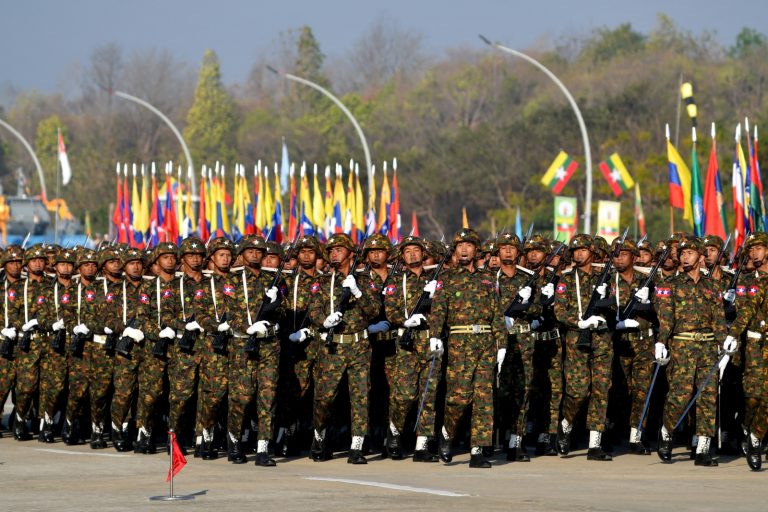Over-extraction of groundwater was already a problem before the coup but experts say it is likely to worsen in the years ahead due to stalled policies and laws, and lack of investment in much-needed infrastructure.
By FRONTIER
It didn’t take Ko Myo Swe Tun* long to realise his new apartment in Yangon’s Thaketa Township had a water problem. The corroded metal pipes and fixtures in his bathroom and kitchen were a dead giveaway.
When the six-storey building was built in 2017, the land owner sunk a two-inch-wide tube well that reaches almost 244 metres (about 800 feet) down into the earth to provide groundwater for residents.
Almost immediately, though, saltwater began seeping into the groundwater, rusting the pipes and corroding everything it touches. When Myo Swe Tun bought his apartment in September 2021, he didn’t realise that the other residents were buying water not only to drink, but also to wash their clothes and to shower in.
Shortly after Myo Swe Tun moved in, residents decided to connect to the Yangon City Development Committee water supply instead. “There was no way we could keep using groundwater from our tube well – it was just too salty,” he told Frontier.
Each resident paid around K200,000 (about US$100) for their connection, he said.
They are far from alone. Many apartment buildings and homes, particularly outside Yangon’s inner suburbs, use groundwater for everyday water needs and buy 20-litre barrels of purified drinking water. In some areas, this is to avoid the cost of a YCDC connection and ongoing charges, but in most cases it’s because the municipal supply is simply not available.
As more people connect, the level and quality of Yangon’s groundwater has started to decline rapidly. Many are finding that their once-clean groundwater has become contaminated due to saltwater intrusion.
“On our street alone, three other apartment buildings have connected to the YCDC supply water recently because their tube wells have had an influx of saltwater,” Myo Swe Tun said.
Water resource experts are warning that the unregulated use of tube wells and overextraction of groundwater are making it harder for the city’s residents to access a safe water supply.
U Myint Thein is a groundwater consultant and former adviser to the National Water Resources Committee from 2016 to 2020. He has almost 40 years of experience in both the government and non-government sectors working on water-related issues, and has studied Yangon’s water supply extensively.
“Saltwater intrusion worsens year by year because of over-extraction of groundwater and failure of Yangon authorities to control public groundwater extraction in Yangon since 1990 – that is, far more water is taken out than the natural recharge,” he told Frontier.
Estuarial areas such as Yangon, where river levels and flows are influenced by the tides, are particularly susceptible. Saltwater is normally kept at bay in an estuarial environment by freshwater outflows underneath the ground, in what is known as a zone of dispersion. When groundwater is over-extracted, whether for human consumption or agriculture, the flow of freshwater towards the tidal river or rivers declines. This can cause saltwater to be drawn into freshwater zone, leading to saltwater intrusion.
Myint Thein said this phenomenon was well understood and occurred in many areas around the world, but Yangon’s municipal officials had shown little concern despite the warning signs.
“The authorities aren’t interested in administrating the groundwater supply for members of the public. They haven’t done anything to control groundwater use.”
Interviews with almost 20 water resource experts, private tube well drilling companies and Yangon residents confirmed that groundwater extraction is almost completely unregulated. YCDC exerts little control over individual well use, neglecting to either inspect or regulate groundwater extraction.
U Kyaw Oo, a member of an advisory group to the National Water Resources Committee, said Yangon’s growing urban sprawl was putting strain on an underprepared system. The only solution, he said, was to invest in better infrastructure, including additional reservoirs to the north of the city.
“Yangon’s population is still increasing, and so is water consumption. It will definitely become a bigger problem in the future – the authorities shouldn’t allow any new wells to be sunk into the groundwater,” he said.

Out of control
In December 2020, YCDC’s Urban Planning Department estimated that per capita consumption in Yangon ranged from 15 gallons (57 litres) a day for a low-income resident to 30 gallons (114 litres) a day for a high-income resident. To meet this demand, YCDC supplies water from four reservoirs and 645 tube wells that it operates. The water drawn from these sources is supposed to cover 50pc of Yangon’s population of 5.2 million people, but an internal YCDC document issued in April 2016 and acquired by Frontier confirmed that in practice it distributes water to just 30pc of households. This is attributed to old pipes, lack of infrastructure and water wastage.
The rest of the city’s population, it seems, have little choice but to rely on groundwater. This is reflected in a case study Myint Thein released earlier this year, in which he estimated that almost 60pc of Yangon residents rely on groundwater for their daily needs. In a city of more than 5 million people, that equates to as many as 250,000 private tube wells and many million gallons being taken out of the groundwater daily.
The authorities are well aware of the problem. In 2020, YCDC released its own groundwater inventory survey charting the average decline in groundwater levels across 27 of the 33 townships in urban Yangon between 1992 and 2018.
Mayangone and Mingaladon were shown to have the lowest groundwater level among the 27 townships, plummeting from 25 and 28 feet below ground, respectively, in 1992 to 45 feet in 2018. However, some other townships had seen similar overall declines, including East Dagon, where groundwater level fell on average from 12 feet to 40 feet over the same period.
Myint Thein said the large declines were due to both population and industrial growth. Some factories operate tube wells 10 inches in diameter which are discharging more than 200,000 gallons each day, he claimed.
One indication of saltwater intrusion is chloride levels. The survey found that 12 townships – mostly in downtown and along the Bago and Hlaing rivers, both of which are tidal – had chloride levels that exceeded World Health Organization standards for drinking water, and in some townships the samples were more than three times higher than the WHO’s recommended maximum.
As a result of the decline in groundwater quality, wells are being sunk deeper than ever before. Myint Thein gave the example of a property in the Thamine area of Mayangone where a well had been sunk to 100 feet in 1995, when the water level was about 10 feet below the surface. At the time, there were few wells in the street; now it has dozens
The situation now is almost unrecognisable. In May this year, Frontier interviewed 10 private tube well drilling companies in Yangon Region to find out about average groundwater levels. The companies told Frontier that the shortest depth they drill to is around 300 feet, with the deepest wells stretching down as far as 700 feet. All agreed that groundwater levels were declining year on year.
“Due to YCDC not being able to supply enough water, the numbers of tube wells being drilled have increased on last year,” said U Aung Myint from Aung’s Family, a private firm based in East Dagon Township that installs more than 20 tube wells each month.
Kyaw Oo, the National Water Resources Committee advisory group member, said climate change would likely exacerbate the current challenges, and without new investment Yangon could find itself facing a “water crisis”.
YCDC’s Engineering Department (Water and Sanitation) did not respond to requests for comment.
Hope runs dry
The problem is only likely to worsen under Senior General Min Aung Hlaing’s military junta, which seized power in February 2021.
The previous Union Solidarity and Development Party and National League for Democracy administrations had taken some steps to improve water supply in Yangon. In a bid to improve efficiency, for example, YCDC in August 2019 invited companies to submit expressions of interest to run parts of the network under a public-private partnership system. Both local and foreign companies were invited to submit proposals for zone-wide water distribution under the city’s master plan.
At the time, then-Yangon Mayor Maung Maung Soe said the initiative was designed to stop illegal water connections, as well as other loss and waste.
“Privatisation is the best solution to help YCDC’s losses,” he was quoted by state media as saying.
The mayor told local media journal The Voice in March 2020 that YCDC also planned to reduce the number of existing tube wells by 2025. By 2040, he said, YCDC aimed to supply water to the city’s entire population, requiring some 330 million gallons a day.
But these promised reforms were disrupted by the February 2021 coup, which saw the military arrest and imprison officials like Maung Maung Soe. Widespread resistance to military rule has crippled both the regime’s finances and its ability to implement development projects. The junta has sought to overturn some policies of the previous administration.
The coup has also limited Myanmar’s ability to draw on support from international donors, and put in doubt numerous water infrastructure projects around the city.
Since 2014, the Japan International Cooperation Agency has been implementing the US$230 million first phase of the Greater Yangon Water Supply Improvement Project, which will see the Lagunbyin pumping station upgraded and a pipeline network rolled out across the four “Dagon Myothit” townships to reach almost 600,000 people. Prior to the coup, the project was due for completion this year.
JICA is also due to provide funding for a second phase that would see water from the Kokkowa River pumped eastward to Hlaing Tharyar and six townships in downtown Yangon. In January 2017, the Japanese and Myanmar governments signed a 25 billion yen ($186 million) loan agreement for the project.
The status of these projects is now unclear. Japan has suspended new development aid since the coup, but has reportedly resumed implementation of existing projects. JICA’s Myanmar office did not respond to requests for comment.
In November 2020, meanwhile, the Asian Development Bank approved a $180 million loan to increase water supplies from the Nga Moe Yeik reservoir by around a third, and to build a new pipeline and pumping station to transfer the treated water to residents. The ADB suspended funding for Myanmar projects a month after the coup, and its website says no money has been disbursed for the water project.
Similarly, Myint Thein said that shortly before the coup the government had submitted a proposal to the World Bank for an extension project focused on Yangon groundwater supplies under the $180 million Ayeyarwady Integrated River Basin Management project.
A draft Groundwater Law, published in state media in December 2019, also appears to have been indefinitely delayed by the military coup. The law would give the authorities the legal framework to manage groundwater supplies, including the drilling of new wells.
The bill carries a fine of K100,000 to K5 million and up to three years in prison for commercial excavations for home and factory uses carried out without a drilling permit, acts that contaminate groundwater, and the extraction of groundwater in excess of the permitted amount.
With the regime struggling to hold onto power, it is unlikely to prioritise long-term challenges like groundwater over-extraction. Residents are also unlikely to heed a law implemented by an administration they consider to be illegitimate.
“Because of the government changes, the authorities are changing their previous plans and decisions,” groundwater consultant Myint Thein told Frontier. “Instability and weaknesses in YCDC water supply management have resulted in less progress – in fact, there has been zero progress.”
* denotes the use of pseudonym for safety reasons







